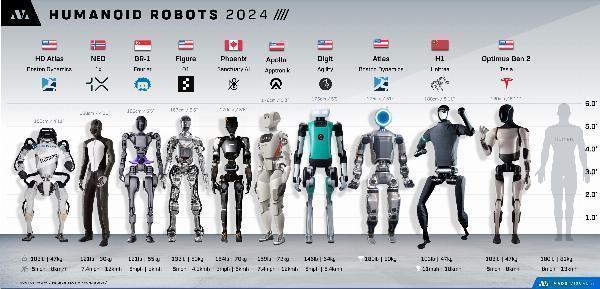Top 10 Humanoid Robots of 2024

Humanoid robots are no longer just a part of science fiction—they are becoming an important part of many industries. In 2024, the development of these robots has reached new levels. This year is especially important because these robots are not only showcasing the latest technologies but are also starting to have a real impact on our daily lives. From healthcare to manufacturing, humanoid robots are changing how we work and live. In this blog, we’ll take a look at the top humanoid robots of 2024, highlighting their innovative features and the ways they are set to transform the world around us.
Understanding Humanoids
Humanoids are robots designed to resemble and mimic human behavior, including physical movements, speech, and even facial expressions. Unlike other types of robots, which may be built for specific tasks or functions, humanoids are crafted to interact with humans in a more natural and intuitive way. Their human-like appearance and abilities make them ideal for roles that require direct interaction, such as caregiving, customer service, and companionship.
The journey of humanoid robots began decades ago, with early models focusing on basic movement and simple tasks. Over the years, technological advancements have driven significant improvements, leading to more sophisticated and capable humanoids. By 2024, these robots have evolved to not only perform complex tasks but also adapt to human emotions and environments, making them more effective and versatile than ever before.
Criteria for Selection
In 2024, the humanoid robots that stand out the most are those pushing the boundaries of technology and innovation. These robots are equipped with advanced AI developments, machine learning, and sensor technologies that allow them to understand and respond to human emotions, perform complex tasks with precision, and even learn from their experiences. Their ability to interact seamlessly with humans and adapt to different environments sets them apart from earlier models.
The practical applications of these humanoids are vast. They are being implemented in healthcare, where they assist with patient care and rehabilitation; in retail, where they provide customer service and support; and in manufacturing, where they enhance productivity by working alongside human employees. These real-world use cases highlight the versatility and effectiveness of humanoid robots in various industries.
The impact of these humanoids on society is profound. They are not only changing the way we work by taking on repetitive or dangerous tasks, but they are also improving our daily lives by providing companionship and support to the elderly or disabled. Economically, the rise of humanoids is expected to boost productivity and efficiency across industries, while also raising important questions about the future of work and the role of humans in a rapidly evolving technological landscape.
Top Humanoids of 2024
As we move through 2024, the landscape of humanoid robotics has seen groundbreaking advancements. Here are the top ten humanoid robots making a significant impact this year:
1. HD Atlas (Boston Dynamics, USA)
Height/Weight: 150 cm (4'11") / 103 lbs (47 kg)
Speed: 5 mph (8 km/h)
Battery: Custom battery providing high power for extended operation.
Processor: Uses a combination of high-speed processors for real-time decision-making.
Sensors: Equipped with depth sensors, LIDAR, and advanced cameras to generate 3D maps of its environment.
Special Features: HD Atlas has exceptional agility and can perform acrobatic maneuvers, making it ideal for dynamic tasks such as search and rescue. It uses model-predictive control for real-time adjustments to its movements, allowing it to adapt quickly to changing environments (Boston Dynamics).
2. NEO (1X, Norway)
Height/Weight: 160 cm (4'11") / 121 lbs (30 kg)
Speed: 7.4 mph (12 km/h)
Battery: Energy-efficient battery system designed for long operational hours.
Processor: High-performance AI-driven processors for complex decision-making.
Sensors: Advanced multi-modal sensors, including visual and tactile sensors for interacting with the environment.
Special Features: NEO is optimized for human-robot collaboration with precise motor control, making it suitable for commercial and household tasks. Its AI system enables it to adapt to various roles with minimal programming (1X).
3. GR-1 (Fourier, Singapore)
Height/Weight: 165 cm (5'5") / 121 lbs (55 kg)
Speed: 5 mph (8 km/h)
Battery: Long-lasting battery with quick charge capabilities.
Processor: AI-based processors that allow for adaptive learning and task optimization.
Sensors: Includes LIDAR, depth cameras, and touch sensors for navigating complex environments.
Special Features: GR-1 is a bipedal robot designed for tasks requiring high dexterity. It is particularly strong in environments that demand both mobility and manipulation, making it ideal for various industrial applications (Fourier Intelligence).
4. Figure 01 (Figure, USA)
Height/Weight: 167 cm (5'6") / 132 lbs (60 kg)
Speed: 4.3 mph (7 km/h)
Battery: Custom battery pack designed for extended operational periods.
Processor: Advanced AI processors enabling continuous learning and task adaptation.
Sensors: Equipped with advanced sensors for tactile feedback and environmental awareness.
Special Features: Figure 01 focuses on precision tasks requiring fine motor skills. Its highly articulated hands and adaptive AI allow it to excel in research and manufacturing environments, where flexibility and accuracy are crucial (Figure AI).
5. Phoenix (Sanctuary AI, Canada)
Height/Weight: 170 cm (5'6") / 154 lbs (70 kg)
Speed: 3 mph (5 km/h)
Battery: High-capacity battery optimized for endurance tasks.
Processor: AI processors designed for general-purpose problem-solving.
Sensors: Utilizes carbon-based AI Control System with advanced perception and interaction capabilities.
Special Features: Phoenix is engineered for general-purpose tasks in industries such as healthcare and retail. Its AI-driven system allows it to adapt quickly to various environments, making it a versatile solution for labor-intensive jobs (Sanctuary AI).
6. Apollo (Apptronik, USA)
Height/Weight: 172 cm (5'8") / 159 lbs (72 kg)
Speed: 7.4 mph (12 km/h)
Battery: Modular battery system allowing for easy replacement and extended operational time.
Processor: High-efficiency processors for managing complex tasks and interactions.
Sensors: Advanced visual and tactile sensors for detailed environmental interaction.
Special Features: Apollo's modular design allows it to be customized for a variety of industrial tasks, from tool operation to logistics. Its energy-efficient systems and adaptability make it a valuable asset in demanding industrial environments (Apptronik).
7. Digit (Agility Robotics, USA)
Height/Weight: 175 cm (5'9") / 146 lbs (64 kg)
Speed: 5 mph (8 km/h)
Battery: Optimized for prolonged usage in field operations, including delivery tasks.
Processor: Utilizes AI processors for real-time decision-making and navigation.
Sensors: Equipped with LIDAR, depth cameras, and IMUs for precise navigation and obstacle avoidance.
Special Features: Digit is designed for logistics and delivery tasks in urban environments. Its bipedal form allows it to navigate stairs and complex spaces, making it a robust solution for last-mile delivery and warehouse automation (Agility Robotics).
8. Atlas (Boston Dynamics, USA)
Height/Weight: 175 cm (5'9") / 180 lbs (80 kg)
Speed: 5.4 mph (5 km/h)
Battery: Advanced battery system supporting high-energy activities.
Processor: High-speed processors for real-time environmental interaction and task execution.
Sensors: Equipped with depth sensors, LIDAR, and high-resolution cameras for dynamic perception.
Special Features: Atlas is renowned for its agility and ability to perform complex dynamic tasks. It features real-time perception and predictive control systems, enabling it to perform tasks like object manipulation and navigation in cluttered environments (Boston Dynamics).
9. H1 (Unitree, China)
Height/Weight: 180 cm (5'11") / 103 lbs (47 kg)
Speed: 11 mph (18 km/h)
Battery: High-performance battery for sustained high-speed operations.
Processor: Advanced processors optimized for high-speed task execution.
Sensors: Multi-modal sensors, including visual and motion sensors, for real-time navigation and interaction.
Special Features: H1 is designed for high-speed, high-agility tasks, making it one of the fastest humanoid robots. It is suitable for applications that require quick reflexes and precision, such as high-speed deliveries or rapid response tasks (Unitree Robotics).
10. Optimus Gen 2 (Tesla, USA)
Height/Weight: 180 cm (5'11") / 130 lbs (59 kg)
Speed: 8 mph (13 km/h)
Battery: Advanced Tesla-designed battery providing long operational life.
Processor: Equipped with Tesla's proprietary AI processors for complex task management.
Sensors: Features tactile sensors on all fingers, advanced visual sensors, and accelerometers for balance and manipulation.
Special Features: The Optimus Gen 2 features 11 degrees of freedom in its hands, allowing for intricate object manipulation. It’s designed for industrial tasks and has shown significant improvements in balance and dexterity, making it capable of performing delicate tasks like threading a needle. The robot is also lighter and faster than its predecessor, highlighting Tesla's advancements in humanoid robotics (Tesla).
These humanoid robots are not only at the forefront of technological innovation but also represent significant steps forward in how robotics will integrate into our daily lives and industries. Each robot's unique features highlight the diverse potential applications, and the profound impact humanoid robots are set to have in the coming years.
The Future of Humanoids
Trends
Looking beyond 2024, humanoid robots are expected to become more autonomous and intelligent, driven by advancements in AI and machine learning. These robots will likely expand into new sectors such as education, hospitality, and home environments, offering services like personal assistance and companionship. Additionally, energy efficiency and modular designs will become more prominent, making these robots more sustainable and adaptable to various tasks. As companies like Softlabs Group, an AI development company, continue to innovate in AI solutions, the potential for humanoid robots to impact even more industries grows exponentially.
Challenges
As humanoid robots advance, ensuring their safety and reliability remains a critical challenge, particularly as they take on more sensitive roles. Ethical concerns, such as the potential for job displacement and the psychological impact of lifelike robots on humans, will also need to be carefully managed. Rigorous testing and thoughtful regulation will be essential to address these issues, especially as the integration of AI into humanoid robots becomes more widespread.
Predictions
In the coming years, humanoid robots are likely to become an integral part of daily life, from managing household chores to performing complex tasks in industrial settings. Their increasing presence will blur the lines between humans and machines, raising new questions and opportunities for society as we adapt to this evolving technology.
Summary
In this blog, we've explored the rapid advancements in humanoid robotics throughout 2024, highlighting the top ten humanoid robots making a significant impact this year. We delved into the key features of these robots, from Tesla’s Optimus Gen 2 to Boston Dynamics’ Atlas, and examined their growing presence in various industries. We also discussed the future trends, challenges, and predictions for humanoid robots, emphasizing their potential to revolutionize daily life and industrial operations.
Final Thoughts
Humanoid robots in 2024 are not just technological marvels; they represent a significant shift in how we integrate machines into our lives. As these robots become more intelligent, autonomous, and versatile, they will play an increasingly vital role in both personal and professional settings. The evolution of humanoids is a clear indicator of the future of technology, where the boundaries between humans and machines will continue to blur, leading to profound changes in society and the global economy. As we move forward, the development and responsible use of humanoid robots will be crucial in shaping a future where technology enhances, rather than disrupts, the human experience.
Note: IndiBlogHub features both user-submitted and editorial content. We do not verify third-party contributions. Read our Disclaimer and Privacy Policyfor details.




